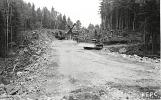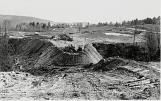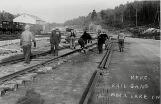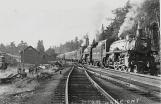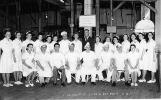14
This image shows a survey crew at work beside the rapids in the winter of 194516
When the project began, Moor Lake C.P.R. Station (Approx. 2 miles south by wagon road) was essentially a passenger stop. All freight had to be transported by truck from the C.P.R. rail yard at Chalk River village. This alternative involved 20 miles of road (mostly highway #17) with a substantial hill on each side of Meilleurs Bay. Upgrading the rail access at Moor Lake Station was a more attractive option. A new road was built between highway #17 and Moor Lake Station and a rail yard with additional sidings and a substantial unloading area was added. This image shows work in progress on the road close to the station18
As with the road to Moor Lake Station, the road to Des Joachims Village was not adequate for heavy equipment traffic loading requirements. So the old Mattawa road which had provided access to the village was replaced with the road still in service in 2004. The photo shows the start of the new road with highway #17 heading east at the top right.Audio Text - Henry Chasse
Harco built the canal - "Harvey", that's Harvey Construction, Harvey Construction built the Swisha Road; Therion Construction built the Moore Lake road, I worked for them too, and Harco dug the canal like I said a while ago and Hydro did the other one. Atlas built the dam at McConnel Lake, a lot of other contractors in the area but I dont remember what they did.
20
Workers are shown adding sidings to expand the rail yard at Moor Lake Station22
A "Double Header" C.P.R. passenger train is shown passing through Moor Lake Station on the main line in 1947. The completed siding tracks installed during the expansion of the Moor Lake rail yard can be seen in the centre of the image with Moor Lake Station building to the left of centre23
1946 and 1947Actual construction began in the fall of 1946 with a small staff and modest infrastructure. 1947 saw a rapid expansion of staff, infrastructure and construction activity. The tent camp gave way to more comfortable lodging in bunk houses and the cafeteria at camp #1 opened for business. A cofferdam was installed across the Ontario channel and form work on the main dam began. Assembly of the Ontario and Quebec concrete mixing plants got underway but rock excavation at the main dam was the priority.
24
A cofferdam was installed across the Ontario channel and form work on the main dam began. Assembly of the Ontario and Quebec concrete mixing plants got underway but rock excavation at the main dam was the priority.26
The opening of the Camp #1 Cafeteria was welcomed by the hungry construction troops. The smoke above the roof of the building is said to be the chef burning the toast.Audio Text - "Q" - J Wright - "A"- Henry Chasse
Q.There were three cafeterias, were they all roughly the same size?
A. Ya, pretty well - ya, like this one would seat 400 people and then there was
one - heck - a stones throw from - there was two of them. The other one was used more
from the Construction, "Harco", that did the canal - they were open 24 hours a day. And
they had one at Swisha the same as that and one at McConnell Lake.
